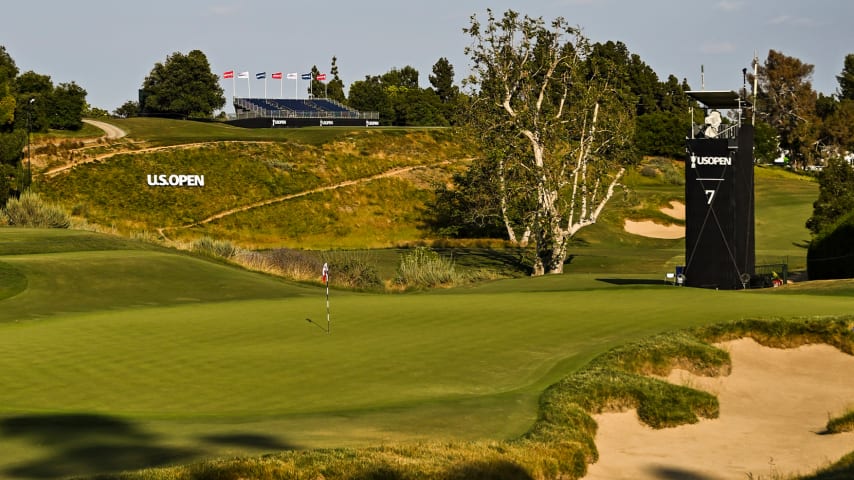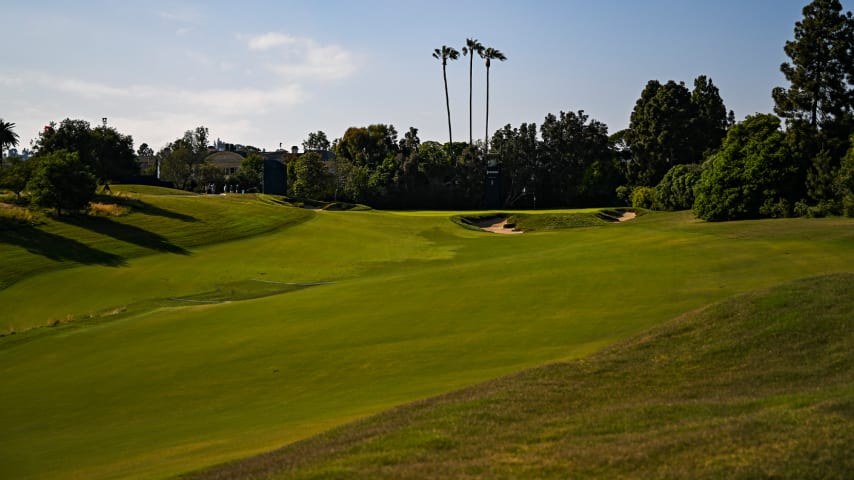Expect the unexpected at this U.S. Open
5 Min Read

Few know the hilly terrain at LACC, where the knowledge is scarce and anticipation is high
LOS ANGELES – Thursday’s opening round of the U.S. Open will be a venture into the unknown.
It has been more than 80 years since professionals have competed on the guarded grounds of Los Angeles Country Club’s North Course, a rustic, rolling layout that traverses hilly terrain. The course offers a glimpse into what the nation’s second-largest city looked like before it was covered in asphalt.
In a city built on the manufactured and artificial, the venue for this week’s U.S. Open emphasizes the natural. That was the purpose of the radical renovation that this club underwent more than a decade ago, the one that readied one of the United States’ great courses for this grand unveiling.
LACC’s allure is subtle, from the understated, all-white clubhouse, a structure that has stood for more than a century, to a course meant to meld seamlessly with its surrounds.
Course architect George C. Thomas said he aimed to elicit the “thrill of nature” in his designs, and he accomplished that at Los Angeles Country Club. There are no water hazards, only narrow barrancas lined by native grasses and shrubs that snake through the property. The flowing bunkers are meant to look like pits created by natural erosion.
“In golf construction, art and utility meet,” Thomas once wrote. “Both are absolutely vital.”

A look into the green at the par-4 third at Los Angeles Country Club. (Keyur Khamar/PGA TOUR)
The course requires players to strike a similar balance. Thanks to everything from ShotLink to Trackman, we now have unprecedented insight into the optimal way to accomplish the main aim of this game, getting the ball in the hole as quickly as possible. Los Angeles Country Club offers a rebuttal to the data-driven age, though.
Numbers hold little value here. Even par is irrelevant on many holes. With players facing a variety of lies and unique playing surfaces, the artistic side of the game will be emphasized as players feel out a unique, and unknown, layout made even more mysterious by several blind shots where slopes and hills obscure the view of the target.
“It’s a design I like,” said Jon Rahm. “It makes you think.”
It’s a place where players have options and no course history to aid their decision-making process. Only a handful of players in this field had competed here before this week. There is no ShotLink data to show how previous players approached the course or even past results to offer clues about the winning score. Rory McIlroy, in an interview with Golf Channel, said the winning score could range from 4 under to 4 over.
“I think there’s a massive range. … It’s hard to compare it to any one golf course but I think there is a mixture of quite a few in here,” McIlroy said. “It’s going to be really interesting to see how guys handle it because there’s no history of how people play it.”
Los Angeles Country Club shares an architect with Riviera and is only a few miles from the annual venue of the PGA TOUR’s Genesis Invitational. The similarities between the venues are scant, however. Riviera sits on relatively flat ground at the base of a canyon. Los Angeles Country Club rolls up and down and over and around. McIlroy said this course is more reminiscent of something from the Australian Sandbelt or Shinnecock Hills on Long Island.
“I don't see a ton of similarities other than where we are,” said Max Homa, who set LACC’s course record in his win at the 2013 Pac-12 Championship and won the 2021 Genesis at Riviera. “They play very different; the grass types are not even close. You could play the ball along the ground a lot at LACC if you wanted to.”
What this is not is a traditional U.S. Open venue. Narrow fairways and thick rough were once considered the ultimate examination for golf in the United States. Then the analytics cracked the code of such setups, showing that they overemphasized driving distance.
Where the numbers reign, a sport is often reduced to quantifiable attributes like speed and strength. Golf has not been exempted from this, but this week offers a less predictable test and an alternative to our reliance on analytics.
Like the course itself, this tournament harkens back to an earlier age.
Los Angeles Country Club’s wide fairways offer players options off the tee and room to swing away, but the holes’ severe slopes make it more difficult than anticipated to keep a ball in the short grass. Where a ball lands is not necessarily near where it will come to rest. And those who miss the fairways will find Bermudagrass rough that McIlroy described as “clumpy.” It’s the first time since 2005 that players have confronted that grass at a U.S. Open.

Looking into the green at the par-3 seventh at Los Angeles Country Club. (Keyur Khamar/PGA TOUR)
Luck will play a role in this championship as players who stray offline will be unable to predict what their lie will look like.
Expect the unexpected at Los Angeles Country Club.
This is a course where players may hit driver off the tee of a par-3 and fairway wood, or less, to start a par-5. There are five par-3s, the first time in 76 years that a U.S. Open venue has had that many, and they can span some 200 yards. The 124-yard 15th is expected to play under 100 yards in at least one round, while two par-3s, Nos. 7 and 11, are longer than 280. The par-5 eighth hole is 537 yards, while the par-4 16th is five yards longer.
“It's got a good mix of holes where you have some of those holes that you really need to get after, and then you have other holes out here where you're kind of hanging on,” said world No. 1 Scottie Scheffler. “You're hitting a lot of different clubs into greens and it gives you a lot of options, and it's a really good test.”
Scheffler played here in the 2017 Walker Cup, and perhaps the ultimate compliment is that he has remembered most of the course’ holes over those six years. “That’s kind of unusual for me,” he admitted.
Another memorable tournament seems imminent.
“It’s got everything,” Rahm said of the course. “It’s got all the ingredients to be a great week.”
Sean Martin is a senior editor for the PGA TOUR. He is a 2004 graduate of Cal Poly-San Luis Obispo. Attending a small school gave him a heart for the underdog, which is why he enjoys telling stories of golf's lesser-known players. Follow Sean Martin on Twitter.




